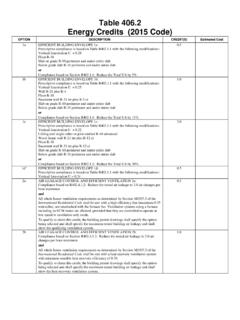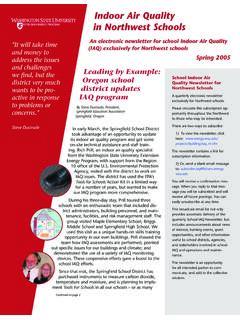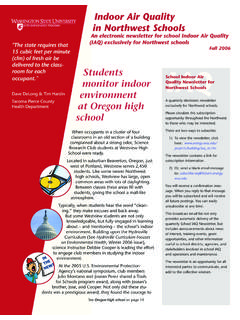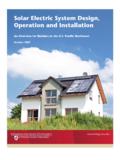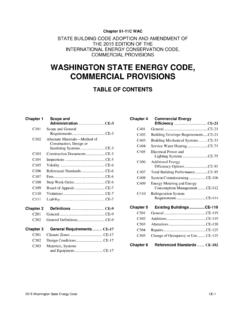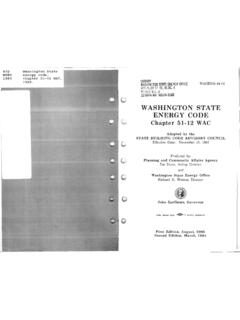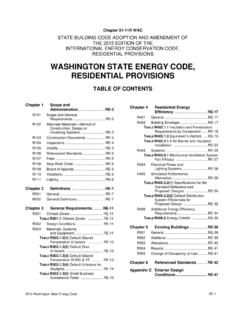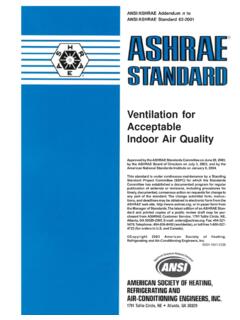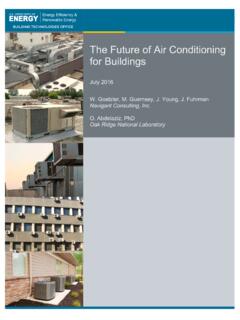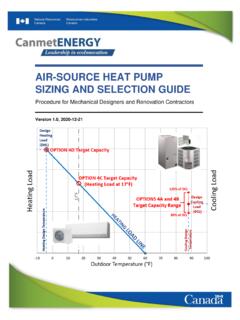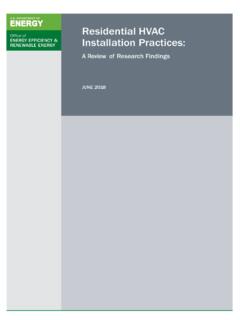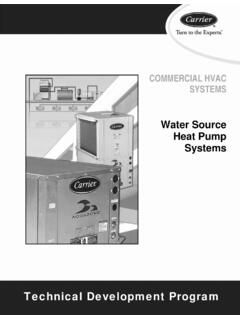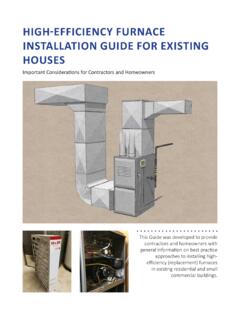Transcription of Why Measure Carbon Dioxide Inside Buildings?
1 Why Measure Carbon Dioxide Inside Buildings? By Rich Prill, Washington State University Extension Energy Program Indoor air quality Workers and students spend about half their waking hours at work or school. Therefore, maintaining adequate indoor air quality (IAQ) in schools and the workplace is becoming a top priority for facility managers and building operating engineers. An essential element for maintaining adequate indoor air quality is outside air to dilute indoor air pollutants and exhaust these contaminants along with moisture and odors from our buildings. Why Measure Carbon Dioxide ? Most heating , ventilation and air conditioning systems (HVAC) re-circulate a significant portion of the indoor air to maintain comfort and reduce energy costs associated with heating or cooling outside air. When occupants and building operators sense air coming out of an air supply duct, it's virtually impossible to judge how much of this air is simply re-circulated air and how much is outside air.
2 Current technology allows easy and relatively inexpensive measurement of Carbon Dioxide ( CO2 ) as an indicator to help ensure ventilation systems (for high density occupancy zones) are delivering the recommended minimum quantities of outside air to the building 's occupants. What is Carbon Dioxide ? Carbon Dioxide is a natural component of air. The amount of CO2 in a given air sample is commonly expressed as parts per million (ppm). The outdoor air in most locations contains down to about 380 parts per million Carbon Dioxide . Higher outdoor CO2. concentrations can be found near vehicle traffic areas, industry and sources of combustion. Where indoor concentrations are elevated (compared to the outside air) the source is usually due to the building 's occupants. People exhale Carbon Dioxide the average adult's breath contains about 35,000 to 50,000 ppm of CO2 (100 times higher than outdoor air).
3 Without adequate ventilation to dilute and remove the CO2 being continuously generated by the occupants, CO2 can accumulate. How much Carbon Dioxide is too much? The concentrations of CO2 found in most schools and offices are well below the 5,000. ppm occupational safety standard (time weighted average for an eight-hour workday within a 40-hour work week) for an industrial workplace. While levels below 5,000 ppm are considered to pose no serious health threat, experience indicates that individuals in schools and offices with elevated CO2 concentrations tend to report drowsiness, lethargy and a general sense that the air is stale. Researchers are looking for links between elevated CO2 concentrations and reduced productivity and achievement. Why Measure Carbon Dioxide in Buildings? What are the guidelines and standards for ventilation?
4 Ventilation rates for schools and office spaces are defined by various codes and standards. The most widely accepted standard is the american society of heating , Refrigeration, and air conditioning engineers (ASHRAE) Standard 62. Some state and local codes have adopted the ASHRAE Standard 62 ventilation requirements. According to ASHRAE Standard 62, classrooms should be provided with 15 cubic feet per minute (cfm) outside air per person, and offices with 20 cfm outside air per person. Ventilation rates for other indoor spaces are also specified. Standard 62 is currently being revised, so these rates may change. Using CO2 as an indicator of ventilation, ASHRAE has recommended indoor CO2. concentrations be maintained at or below 1,000 ppm in schools and 800 ppm in offices (see chart below). Clearly the outdoor CO2 concentration directly impacts the indoor concentration.
5 Therefore, it is critical to Measure outdoor CO2 levels when assessing indoor concentrations. ASHRAE recommends indoor CO2 levels not exceed the outdoor concentration by more than about 600 ppm. The relationship between CO2 levels and outside air ventilation rate can be illustrated with the following table when outdoor CO2 is about 350 ppm: Ventilation and Resultant CO2 Concentrations Carbon Dioxide Outside Air CO2 Differential (cfm per person) ( Inside /outside). 800 ppm suggests about 20 cfm (or less) 500 ppm 1,000 ppm suggests about 15 cfm (or less) 650 ppm 1,400 ppm suggests about 10 cfm (or less) 1,050 ppm 2,400 ppm suggests about 5 cfm (or less) 2,050 ppm Note: The CO2 values in this table are approximate, and based on a constant number of sedentary adult occupants, a constant ventilation rate, an outdoor air CO2 concentration of about 380 ppm, and good mixing of the indoor air.
6 Is it that simple? Unfortunately, the interpretation of the CO2 data is often a more significant source of error than instrument accuracy. Meaningful assumptions about ventilation rate based on CO2 values require the building or zone to be occupied long enough to allow the CO2. levels to reach a balance with the ventilation rate. This balance is known variously as equilibrium, unity or steady-state. In an occupied building with a very low ventilation rate the CO2 levels will likely continue to increase throughout the day, never reaching a steady-state concentration. On the other hand, buildings with an aggressive ventilation rate and good mixing of the outside air may prevent CO2 from accumulating much beyond outdoor levels resulting in low CO2 concentrations throughout the day. Washington State University Extension Energy Program 2.
7 Why Measure Carbon Dioxide in Buildings? Unless this steady-state or equilibrium has been reached, the building ventilation rate can be overestimated. For example, consider a CO2 measurement taken in a school classroom during first period. It is unlikely that the CO2 concentration will have accumulated to the point where equilibrium has been reached. Therefore, assumptions of outside air ventilation rates based on this CO2 measurement will lead to an overestimation of the ventilation rate. Thus low CO2 readings don't necessarily mean adequate ventilation. On the other hand, consider a CO2 measurement taken in the same classroom during the last period of the day. Assuming the ventilation rate and occupancy of the classroom have remained fairly consistent throughout the day, it is reasonable to assume that a CO2. concentration below about 1,000 ppm indicates 15 cfm per person, assuming also that the outside air CO2 is in the 350 ppm range (650 ppm differential Inside minus outside).
8 Sources of error include ventilation systems that modulate the amount of outside air allowed into the building over the course of a day, occupancy rates that fluctuate significantly and measurement errors (instrument or calibration problems, measurement location, and/or poor mixing of the air within the space). Using CO2 to calculate percent outside air Direct measurement of the amount of outside air entering large air handling units can be both difficult and unreliable. Measuring the concentration of Carbon Dioxide in the outside air, return air and mixed air streams is often much easier than other methods. The values obtained are used in the following formula to determine the percentage of outside air for a particular air-handling unit Cr -Cs The formula: % Outside Air (OSA) = --------------------------- X 100. Cr -Co Where: C o is the Carbon Dioxide concentration (ppm) in the outside air C r is the Carbon Dioxide concentration (ppm) in the return air C s is the Carbon Dioxide concentration (ppm) in the supply air (or mixed air).
9 The total supply air volume is required in order to calculate the approximate cfm of outside air supplied to the building using the percentage: Outside Air (cfm) = % Outside Air X Total Supply Air (cfm). Today's technology and IAQ. Today, the measurement of Carbon Dioxide is an important tool to help ensure adequate outside air ventilation while simultaneously saving energy by reducing the number of over-ventilated buildings. Technological breakthroughs have made it possible to use relatively inexpensive CO2 sensors to continuously monitor the CO2 in buildings. These Washington State University Extension Energy Program 3. Why Measure Carbon Dioxide in Buildings? CO2 values can be used by the heating , ventilation and air- conditioning (HVAC) control system to automatically modulate the volume of outside air to maintain indoor CO2 at or below a preset target concentration.
10 This strategy is known as demand controlled ventilation (DCV). DCV systems are especially useful for those spaces or zones that experience variable occupancy rates: The ventilation rate responds proportionally to changes in the occupancy density. What do these instruments cost and how accurate are they? The accuracy of most of the CO2 measurement instruments available today is more than adequate for use as an indicator of ventilation in offices and schools. The accuracy of these devices requires occasional checks. Some of these instruments Measure only CO2. while others will simultaneously Measure temperature, relative humidity and other gases such as Carbon monoxide. Instruments that either record internally or have output capability to an external data logger are valuable for trending and troubleshooting. The cost of these instruments ranges from about $500 to more than $5,000 depending on features.
